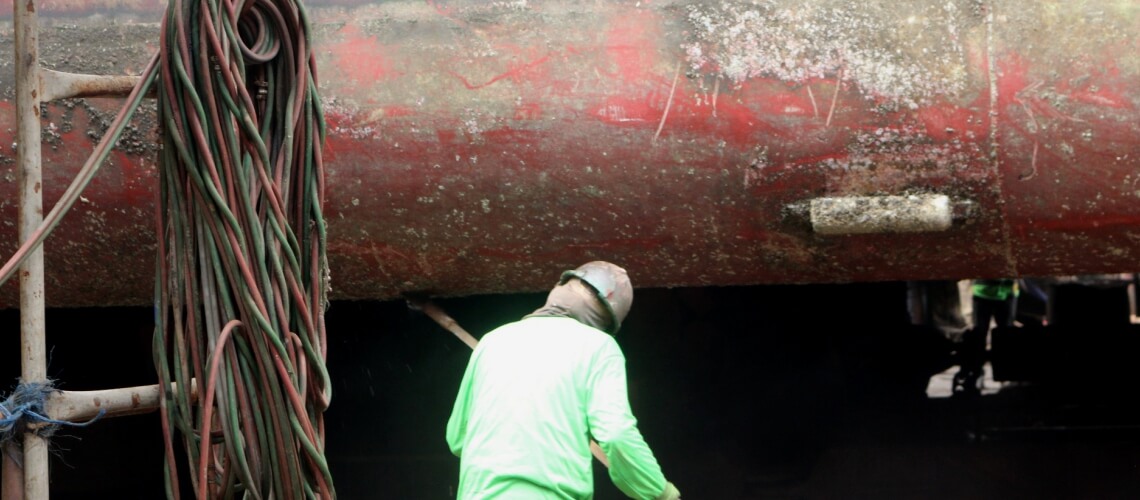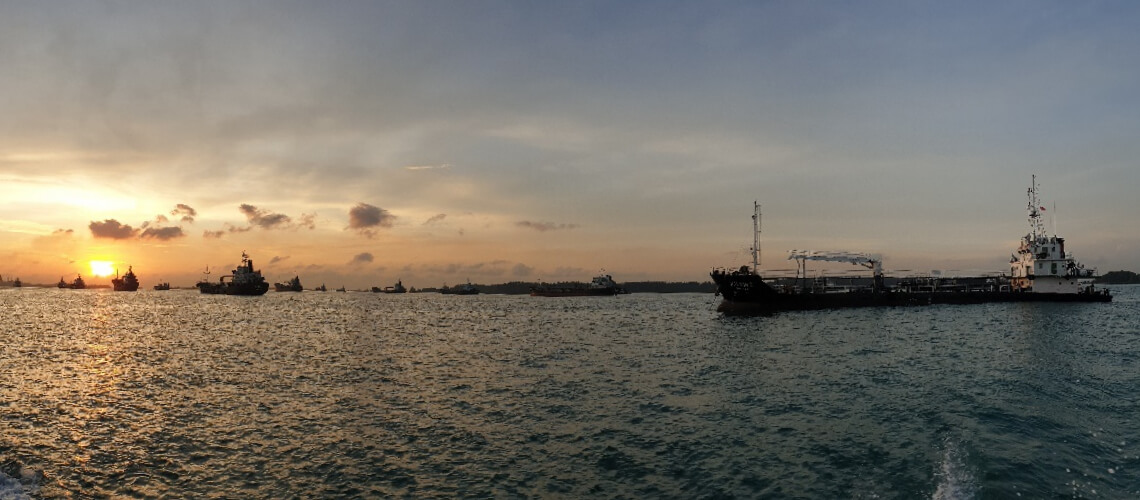

Breadcrumb
GloFouling Partnerships Project

What is biofouling, and why does it matter?
Biofouling, the attachment of living organisms to artificial surfaces, is a seemingly innocuous process that nonetheless threatens the health of the world’s oceans. The organisms can travel attached to shipping hulls and other equipment, thus entering new environments around the world as invasive aquatic species (IAS).
These invasive species can wreak havoc in the areas of environmental health, ecosystem services, fishing and aquaculture. Biofouling can also damage the equipment it accumulates on, reducing the efficiency of shipping and contributing to climate change.
Biofouling in Southeast Asia
Over 40% of international trade passes through Southeast Asia. This exposes the region’s marine ecosystems to invasive species from around the world. For example, shellfish from the Caribbean have been found in Southeast Asian ports. Once established, it is difficult to impossible to remove these species.
There is a lack of specific information on invasive port species in Southeast Asia, which makes it harder to measure and thus reduce the problem.
GloFouling Partnerships
In July 2011, the Marine Environment Protection Committee (MEPC) of the International Maritime Organization (IMO) adopted the Guidelines for the Control and Management of Ships’ Biofouling to Minimize the Transfer of Invasive Aquatic Species (IMO Biofouling Guidelines) – a set of voluntary guidelines meant to provide a globally consistent approach to the management of biofouling. The IMO Biofouling Guidelines have been supplemented by the Guidance for Minimizing the Transfer of Invasive Aquatic Species as Biofouling (Hull Fouling) for Recreational Craft.
The GEF-UNDP-IMO GloFouling Partnerships project (www.glofouling.imo.org) assists developing countries to implement the IMO Biofouling Guidelines and other best management practices. Part of this goal is to work towards a consistent regional approach to biofouling management to minimize the transfer of IAS. Twelve selected Lead Partnering Countries (LPCs) are part of the project (Brazil, Ecuador, Fiji, Indonesia, Jordan, Madagascar, Mauritius, Mexico, Peru, The Philippines, Sri Lanka and Tonga) and spearhead the efforts at the national level, while also playing a catalytic role at the regional level. An additional thirteen Partnering Countries (PCs) are expected to lay the foundation for biofouling management at the national level and participate and engage in regional activities and initiatives.
Set up to tackle the issue of biofouling in developing regions across the world, GloFouling Partnerships is part of the wider efforts by the International Maritime Organization (IMO), in collaboration with the United Nations Development Programme (UNDP) and the Global Environment Facility (GEF), to protect marine ecosystems from the negative effects of invasive species.
Partnerships in Environmental Management for the Seas of East Asia (PEMSEA) is joining global efforts to stop the impact of invasive species across maritime industries. Improved biofouling management also aims to help drive progress towards meeting multiple UN Sustainable Development Goals (UN SDGs).
Southeast Asian Partner Countries
Within Southeast Asia, Indonesia and the Philippines are leading partners in this project. Both countries share the following similarities: they are located within the Coral Triangle; have coastal communities that rely on fisheries for their livelihoods; are tied to global international shipping; and both countries rely on their coastal waters for new industries such as aquaculture and ecotourism.
In Indonesia, a range of agencies from transportation, fisheries, the environment, science and academe led by the Directorate General of Sea Transportation have partnered together as part of this initiative. The first envisioned step is the carrying out of a port biological baseline survey. The lack of information in the region is a challenge for understanding the issue of biofouling, and such surveys will go a long way towards tackling this.
The Philippines has similarly brought together a range of organizations and academic institutions, with the focal point being the Maritime Industry Authority (MARINA). There are currently no biofouling-related regulations in the country, and no reliable and cohesive data on marine invasive species. To address this, the Philippines is now preparing a national plan of action to deal with the issue of biofouling.
Ongoing work
Five regional centres or Secretariats – named “Regional Coordinating Organizations (RCOs)” in the context of the project - including PEMSEA - participate in the GloFouling Partnerships project to address the issue of biofouling management at the regional level by working towards the establishment of regional strategies and action plans to manage biofouling within their respective regions. As a first step, work has been conducted to raise awareness at the regional level on the issue of aquatic invasive species introduced via ships’ biofouling. All five RCOs organized regional awareness-raising online seminars during 2021.
In November 2021, to facilitate the development of regional strategies, the GloFouling Partnerships project invited all regional coordinators to participate in a virtual roundtable, please find attached the link to the proceedings. During this roundtable meeting, a draft Regional Strategy Template was discussed and a generic document adopted for use by each region. The Template provides common key elements for a strategy addressing ship’s biofouling management, and can serve as a canvas for the development of regionally harmonized management arrangements by each regional Secretariat that fit their respective specific needs.
To lead this work, each region will establish a Regional Task Force (or use an existing working group or task force, as appropriate). This Regional Task Force will have representation from all countries in the region and will primarily serve as a mechanism to develop and update the regional strategy and its action plan and oversee its implementation.
Regional Strategy and Action Plan
The Regional Strategy on Biofouling Management in the East Asian Seas (EAS) Region was agreed upon by the Regional Task Force members of biofouling management (Glofouling Partnership) on 22 September 2023. Subsequently, the Action Plan was agreed by the same task force in January 2024.
Regional Task Force Proceedings
The Third Regional Task Force Meeting on Biofouling Management and Invasive Species, held on 20-22 September 2023, fully endorsed the regional strategy and agreed to develop an action plan for consideration by the ASEAN Working Group on Maritime Transport and IMO GloFouling Project. It can be accessed here.
The Second Regional Task Force Meeting on Biofouling Management and Invasive Aquatic Species, held on 23-25 November 2022, further reviewed the updated draft regional strategy. It can be accessed here.
The First Regional Task Force Meeting on Biofouling Management and Invasive Aquatics Species, held on 28 April 2022 can be accessed here.
Relevant Links
Accomplishments of GloFouling Partnerships in 2021 and the project’s activities in 2022
The GloFouling Partnerships project had a significant impact at the United Nations Climate Change Conference (COP 26), last November in Glasgow, UK. The Project hosted a side event as part of the official UNFCCC programme which showcased the full potential of ship’s biofouling management to curb Greenhouse Gas (GHG) emissions.
The introduction and establishment of Invasive Aquatic Species (IAS) is considered as one of the threats to the biodiversity of the world’s freshwater, coastal and marine ecosystems.
Proceedings of the Regional Seminar on Biofouling Management and Invasive Aquatic Species
The GEF-UNDP-IMO GloFouling Partnerships Project is aimed at catalyzing government action, industry innovation and capacity building in order to reduce the transfer of Invasive Aquatic Species (IAS) from international shipping and other marine sectors in a holistic approach.
This regional stock taking report on the state of biofouling management and approaches in the EAS region served as one of the reference materials of the awareness raising seminar on the issue of minimizing the transfer of invasive aquatic species through biofouling and exchange information and knowledge on biofouling management and approaches in countries in the region.
The Final Report of the National Status Assessment on Biofouling Management in Indonesia
The introduction of Invasive Aquatic Species (IAS) to new environments by ships and other mobile marine structures has been identified as a major threat to world’s oceans and the conservation of biodiversity.
Marine biological invasion via the maritime industry is one of the greatest threats to marine biodiversity.